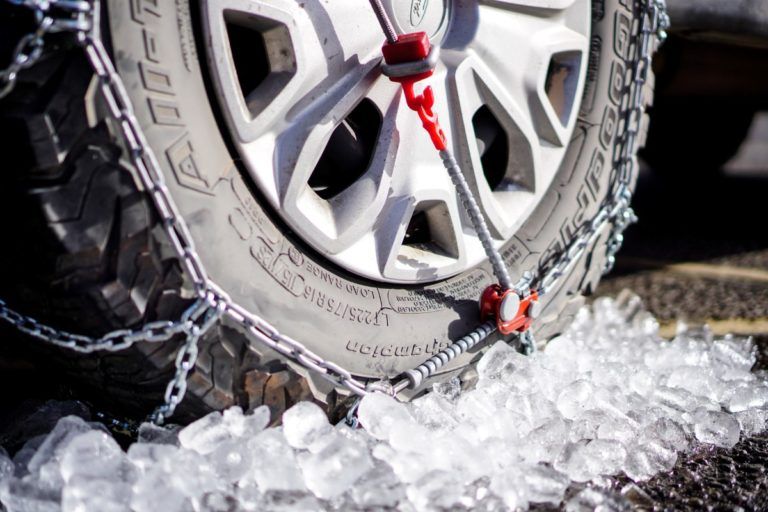If you travel to the mountains or snowy areas regularly, sooner or later you’re going to have to use tire chains. Start by getting the right set for your vehicle at your local Les Schwab.
Quick-fit chains are not your grandpa’s tire chains. They are MUCH simpler to put on and take off. Here are a video, step-by-step instructions, and driving safety tips for installing quick-fit tire chains on your vehicle.
When you need chains, driving conditions are nasty. Snow is coming down, passing traffic is spraying slush, dirty water is dripping off your wheel wells, the road is slick, and it may be dark. Don’t make this the first time you put on your chains.
Practice installing your new chains once BEFORE you travel. Take advantage of a dry garage or driveway to make sure your winter tire chains are the right size and you’re comfortable putting them on. If needed, the professionals at Les Schwab Tire Centers can help.
Put together a simple winter road trip safety kit with warm gloves, waterproof layers, and other items to make your winter driving more safe and comfortable. In the winter, always carry this emergency kit and tire chains in your vehicle.
Once you’re comfortable installing your chains, you’re ready to hit the snow.
Be Safe. If you’re on the road, pull off as far as possible onto a safe shoulder. Flip on your hazard lights. Put on your waterproof layers, hat, headlamp, and gloves from your winter road trip kit.
Identify the Correct Tires. If your vehicle is front-wheel drive, the chains go on the front. If it’s rear-wheel drive, chains go on the back. If it’s all-wheel drive, please check your owner’s manual. If you’re not sure, you can ask the experts at Les Schwab for help.
Pull Out Chains & Instructions. With your vehicle parked, open the bag and pull out your instructions and your first chain. Each bag comes with two chains. The plastic instruction mat that comes with your chains can be used as a barrier between you and the snow to keep you dry.
Untangle Your Chains. Holding them from the plastic-covered cable, make sure everything is straight and the chains are not looped over one another. Hold up your chains so the yellow end is in your left hand and the blue end is in your right.
The chains should hang loosely and the metal hooks seen along the yellow and blue sections should be facing away from you so they don’t damage your tires.
Place Chains onto Your Tire and Connect the Cable. Lay your chains on the ground and push them behind the tire, yellow cable end first, from the right side to the left.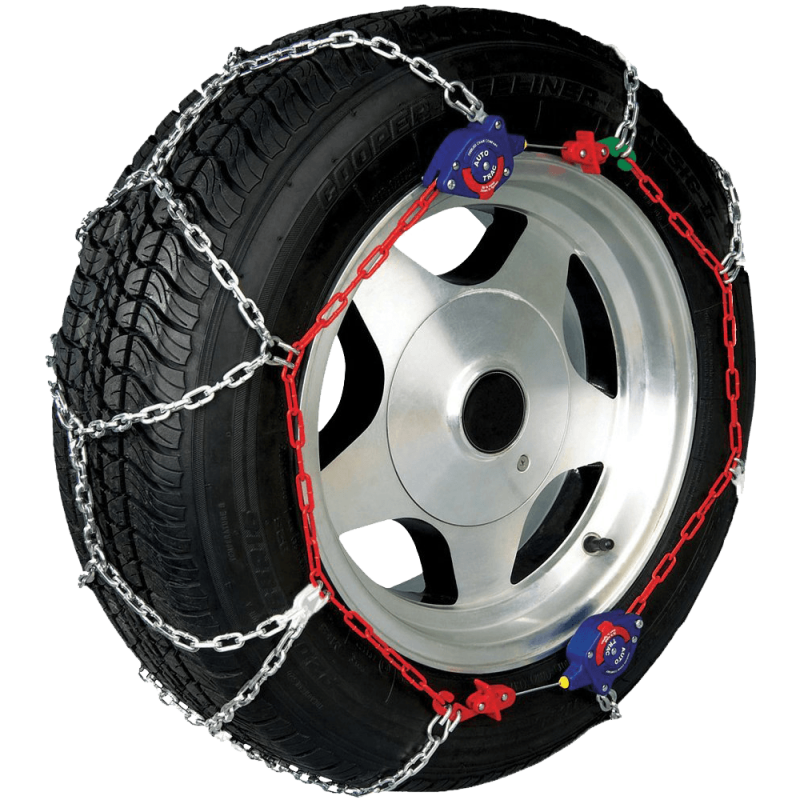
Once the chains are centered behind the wheel, grab both ends and pull them up over the top of the tire. You should feel the chains against your axle.
This will allow you to easily connect the yellow and blue ends of the cable by slipping one end into the other and pulling them into place.
Connect the Red Hook. Now that the cable is connected on top, look for the red hook directly opposite the cable connection. Connect the red hook on the right to the first available gold link on the left.
Check the Diamond Shape. Push the connected chain over the top of the tire. You should see the diamond shape in the chains against your tire. Between each of those diamonds is the center rail, which should be placed down the middle of the tire tread.
Connect the Red Chain Along the Bottom.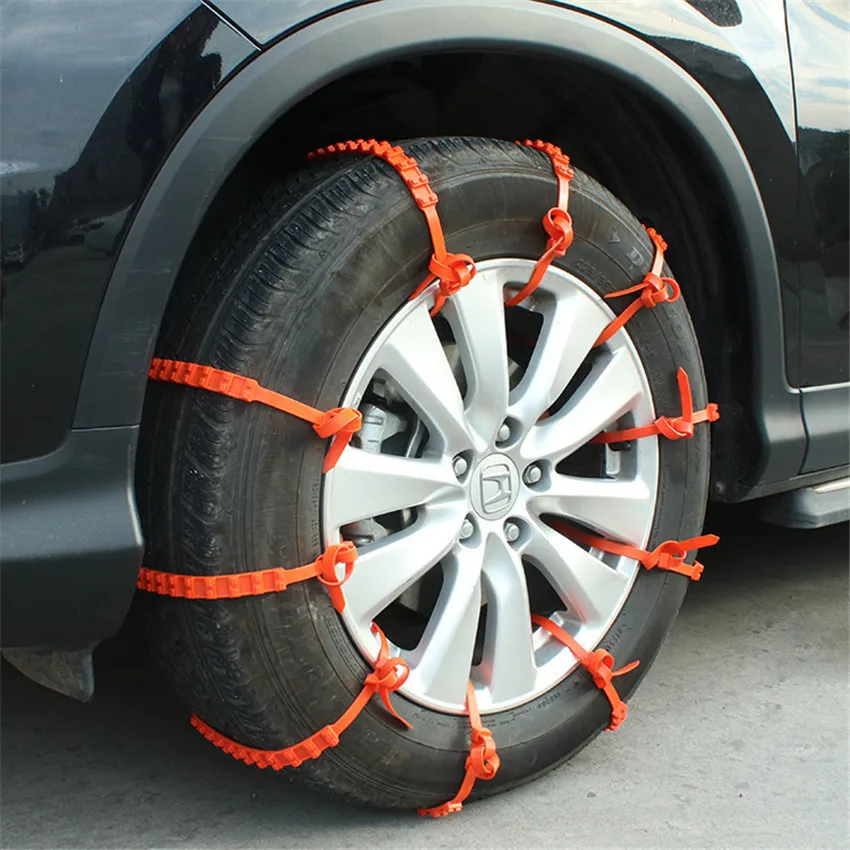 Now that the cable is connected on top, look for the red hook directly opposite the cable connection. Connect the red hook on the right to the first available gold link on the left. Push the connected chain over the top of the tire.
Now that the cable is connected on top, look for the red hook directly opposite the cable connection. Connect the red hook on the right to the first available gold link on the left. Push the connected chain over the top of the tire.
The bottom of the chains includes a red draw chain with bungee on your right, and a chain guide on the left. Pull these out towards yourself.
Take the long red chain and run it through the chain guide and pull as tight as you can with both hands. Don’t pull using the bungee. As you pull, one of the chain links will find its way into the notch on the red chain guide, locking it into place.
Using the bungee end of the red chain, pull it through one or both of the red loops and secure it to a gold-side chain opposite the red loops. If you can’t get it through both loops, that’s ok, pull tight through one and attach it to a side chain to the left of the loop.
Repeat on Second Tire. Repeat these steps to install chains on the other side of your vehicle.
Repeat these steps to install chains on the other side of your vehicle.
Drive Forward Slightly. The next step is to drive forward about 15 feet, or a full car length. This gives the chains a chance to relax and settle on your tires.
Re-tighten Chains. To take up any slack, unhook the rubber end of the red draw chain and pull it tight again. Once it’s tight, guide the red chain through the loops and, again, securely latch the bungee end to the gold-side chain.
The chains should be tight on the tire. And, be sure to stop if you hear them making any contact with your vehicle. If your chains are still loose, unhook the bungee and adjust the red hook straight across from the chain guide. Unhook and reattach to the tightest position on one of the three gold chain links. It’s okay if the extra links are hanging loosely. Now, you’re ready to reattach your bungee.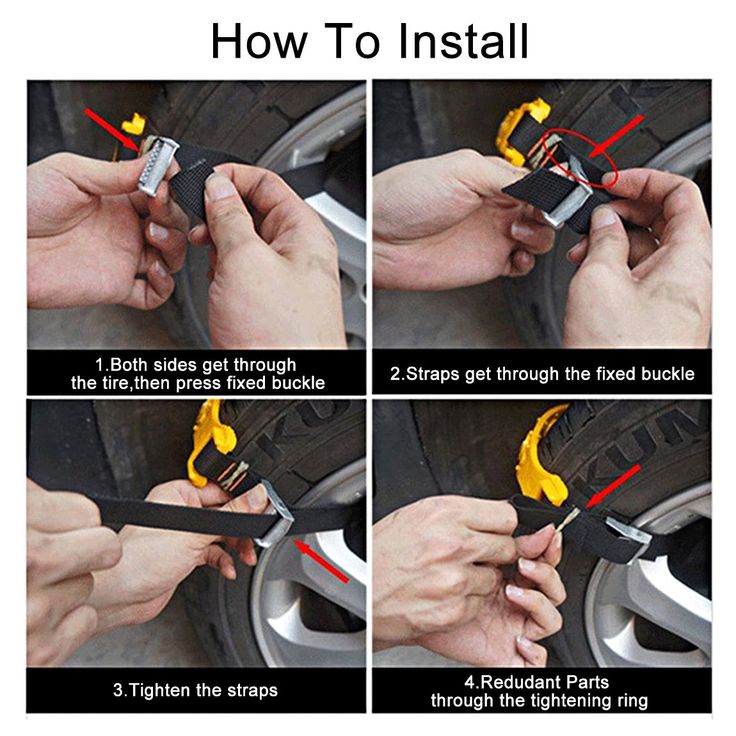
While driving with tire chains, listen for a loud sound of slapping, or metal on metal. If you hear any indication that a chain may be broken or hitting your car, STOP as soon as safely possible. Loose or broken chains that flap can wrap around a strut or shock component, causing big damage to your vehicle. To help prevent damage, here are a few tips for driving when you have winter chains installed on your vehicle.
Pull over in a safe location and remove the chains. Start by unhooking the bungee and chain from the guide, removing them from the tensioner. Unlatch the red hook, and then undo the blue and yellow cable connection. Once all of your chains are off and lying flat on the ground, pull backward or forward slowly a few feet so you can safely pick them up.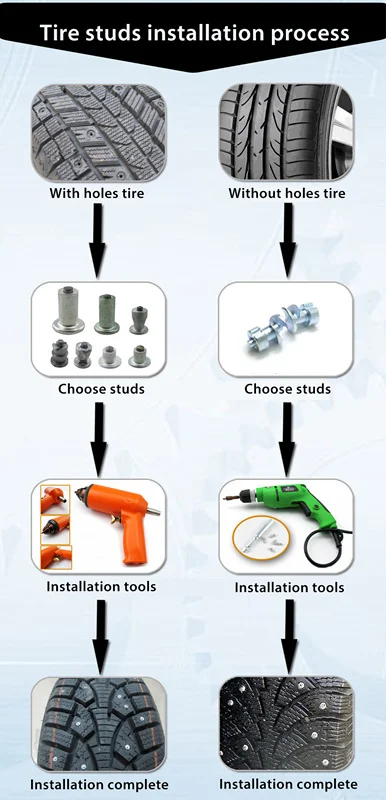
At the end of your trip, lay your chains out in the garage and let them dry. If you pack them wet, they can rust.
Also check them for wear, especially if you’ve driven them on asphalt for any distance. Look for flat spots, and replace the chains if you find some.
Link at left shows flattening from wear. Link in center shows sharp edge from wear that can damage a tire.
Remember, if you don’t use your chains all winter long, you can return them with proof of purchase to any Les Schwab for a full refund in the spring.
Get your next set of Quick-Fit chains, along with a few tips on how to install them, at your local Les Schwab, where doing the right thing matters.
Want more tips on winter road safety? See 19 Winter Driving Resources You Can’t Do Without.
Get More Winter Tips
With some places in the United States seeing around 125 inches of snow per year, it’s important to be prepared for snowy driving conditions during the winter months. In mountainous or extremely snowy areas, utilizing snow chains is sometimes the only way to keep your car moving.
In mountainous or extremely snowy areas, utilizing snow chains is sometimes the only way to keep your car moving.
While winter tires can provide you with traction, they often don’t give you enough to help you in deep snow or slippery situations.
If you’ve never used snow chains before, you might be wondering, “how do snow chains work?” Advanced preparation, practice, and the right equipment will increase your comfort and safety when driving in blizzard weather.
This guide will discuss the basics of tire chains and how you can install them.
Tire chains are a chain system that’s designed to cover the wheel set-up or tire on your vehicle. When installed correctly, they provide you with better vehicle traction in the snow. Snow chains can also give you added traction when driving on frozen surfaces or ice.
There are several different designs of snow chains. One design wraps around the tire and is held together by tensioners. Another design covers the tire’s tread pattern and is mounted to the wheel.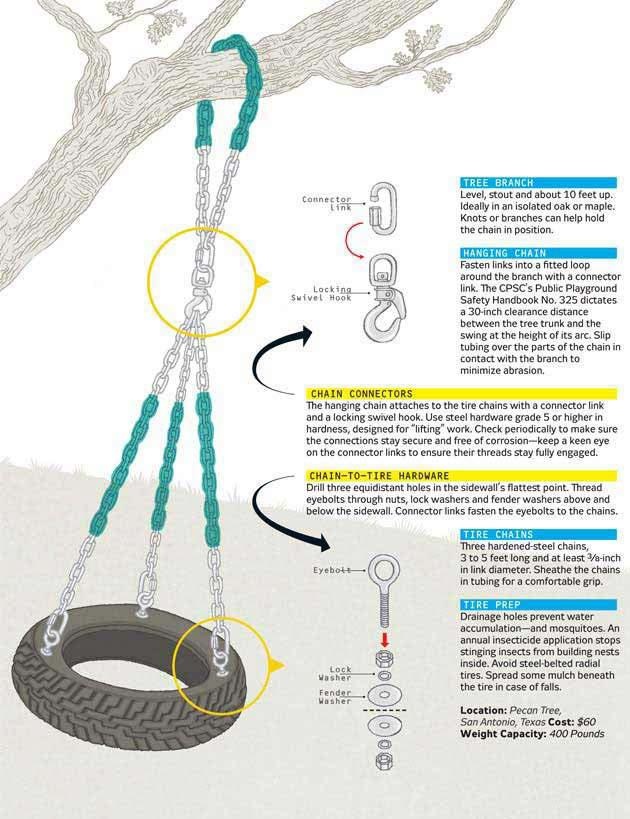
Snow chains can effectively dig into snow and frozen surfaces. The chains can grip the road and allow your wheels to rotate freely. Snow chains also help prevent your vehicle from skidding.
Keep in mind that when you have snow chains installed on your vehicle, you can’t drive at a high speed. Another thing to keep in mind is that you should always put them on your vehicle before you think they’re needed. When the roads start to get covered with snow, it’s always good practice to pull over and put on your chains.
Snow chains aren’t dangerous to put on. The thing you need to be mindful of is the other drivers and road conditions at the time.
After you put the snow chains on, test them before you head back out on the road. You want to ensure that there are no dangling or loose parts. This can result in the snow chains flying off and causing damage.
The ideal place to install snow chains is in a quiet parking lot, but that isn’t always the case.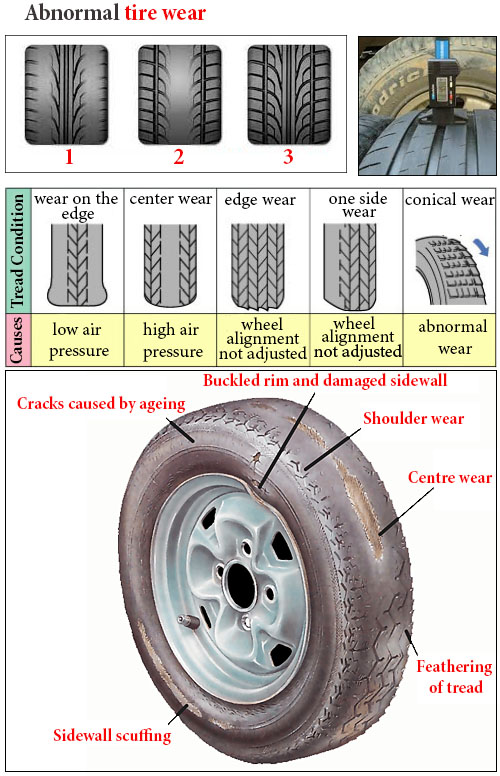 If you need to install them on the side of the road, pull over as far as you can. Put on your hazard lights so other drivers can see you, especially during a dangerous snowstorm.
If you need to install them on the side of the road, pull over as far as you can. Put on your hazard lights so other drivers can see you, especially during a dangerous snowstorm.
Before you exit your vehicle, ensure that your parking brake is engaged. You want to prevent any dangerous movement or the car from rolling away.
All you need to install snow chains are the chains themselves. You can also keep a roadside safety kit nearby with emergency reflectors for your protection. One thing you’ll need to check before you install the snow chains is which of your wheels are the driven wheels.
If your car is a front-wheel drive, the chains will go on the front wheels. Install rear-wheel-drive chains on the rear wheels of the vehicle. Four and all-wheel drive cars can utilize four snow chains.
Follow the below steps when installing snow chains on your vehicle:
Before you start driving again, ensure that your chains are installed evenly.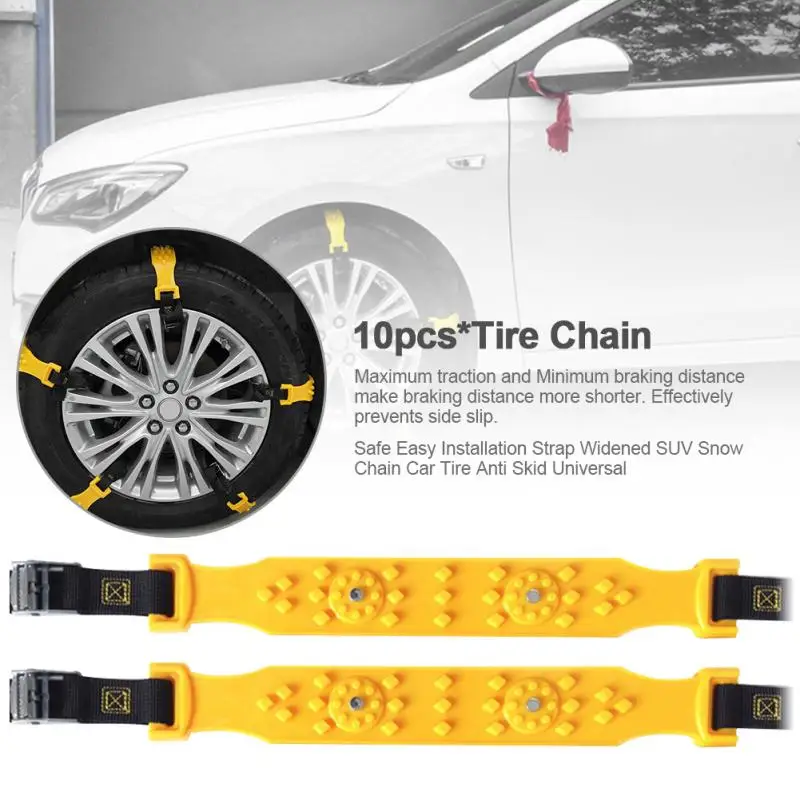 They should run straight around the tire sides. If they’re misaligned or loose, fix the issue before you start driving.
They should run straight around the tire sides. If they’re misaligned or loose, fix the issue before you start driving.
Next, drive about 100 feet. Check your snow chains again. If everything looks good, you’re ready to head back out onto the road.
You should purchase snow chains before you head out on a snowy mountain road. There aren’t many places that sell snow chains or carry a full selection. You also can’t purchase snow chains where there is a chain checkpoint.
Most gas stations, big box stores, and tire shops sell snow chains. Look up your tire size in your vehicle’s manual so you get the right size.
As we mentioned before, you’ll only need two snow chains for your vehicle. The only exception is if you have an all- or four-wheel drive car.
Snow tires are designed for better performance and traction on snow and ice. In many scenarios, snow tires are all you need for driving on snowy roads. You often don’t need another traction device, like cables or chains.
You often don’t need another traction device, like cables or chains.
Cables wrap around your vehicle’s tires like chains. They help your car grip the road when it’s icy or snowy.
Cables are more lightweight than chains and can be easier to install. However, cables don’t last as long as snow chains. They’re a good option if you don’t require them very often.
The department of transportation where you’re driving will notify you when chains are required. You can check their website for road conditions before you start driving. There will also be a sign on the highway indicating that you need to put your chains on.
Snow chains can damage your tires if they’re not installed improperly. They can also cause some damage if they contact the road.
Make sure that your snow chains are installed correctly. Only use them on roads that have a layer of ice or snow. Once the road is clear, take off the chains.
Now that we’ve answered the question of, “how do snow chains work,” you’re ready to drive safely this winter. Driving with snow chains and moving slowly is key to remaining safe during inclement weather.
If your’e looking for a day to day winter driving solution to help improve your tire traction consider purchasing a set of a winter tires! Simply download the Treads App and we’ll send an installer to your home to swap on your winter tires for you!
Category: Interesting news.
The truck tire industry is developing rapidly. Designers improve the rubber compound, improve the tread pattern - and still, in winter it is impossible to do without such an old-fashioned accessory as snow chains . Consider why the driver needs chains and how to install them correctly.
Snow chains are used off-road, in ice and to improve the grip of wheels with the road.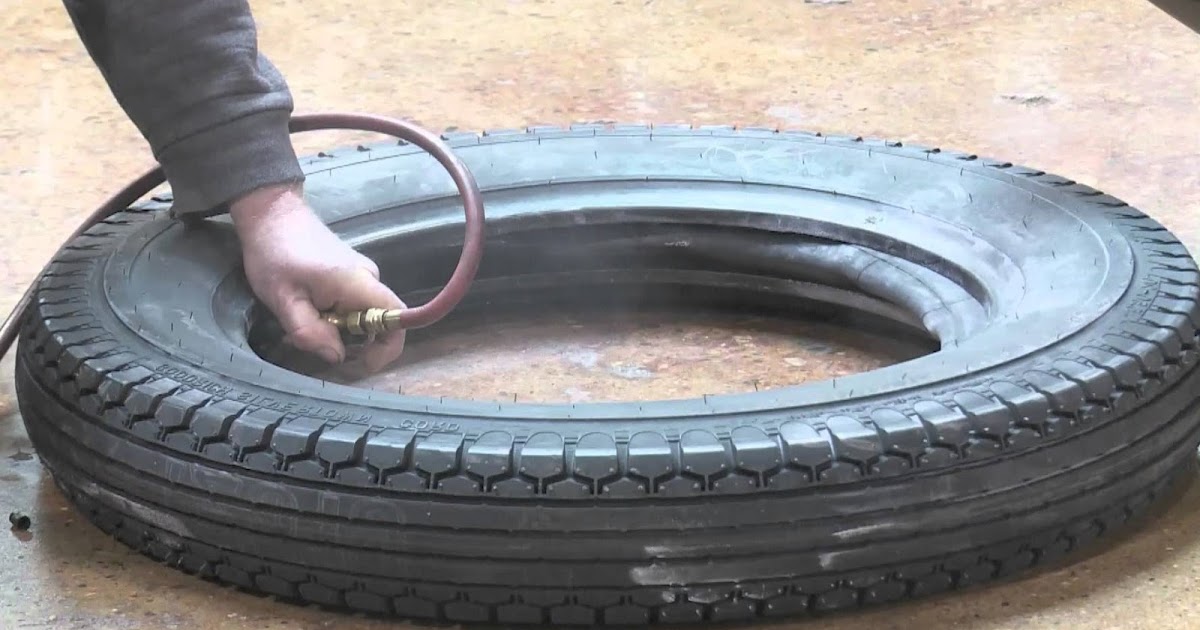
Due to the fact that the pattern of the chain protrudes outward and the contact area of the chains with the road is smaller than that of the wheel, there are gaps between the chain and the tire, the vehicle's flotation is improved, and wheel slip is prevented.
The main purpose for which truck drivers put chains on their wheels - is to ensure a confident ride on slippery roads and in snowdrifts, to increase the stability and controllability of the car due to better grip.

Experienced drivers always carry chains on their wheels. They rescue not only on the ice, but also help out at the cargo terminal if the snow is falling faster than it is removed by public utilities.
The variety of types allows you to find an option for any task - for certain types of trucks, for example, MAN and Scania, chains can be of different “caliber”, and their pattern is made in the form of “honeycombs”, “ladders”, etc. - depending on the type of road surface.
For heavy trucks and trucks, studded chains are mainly used to ensure tire grip in the most difficult areas.
In Europe and Scandinavia, road sections where chains must be used are marked with special signs. Not far from dangerous areas - sites for installing chains.
The requirements for installing chains in different countries are different: somewhere it is enough to “arm” only the drive axle, somewhere you need to put chains on all the wheels of the tractor and even on the wheels of the semi-trailer.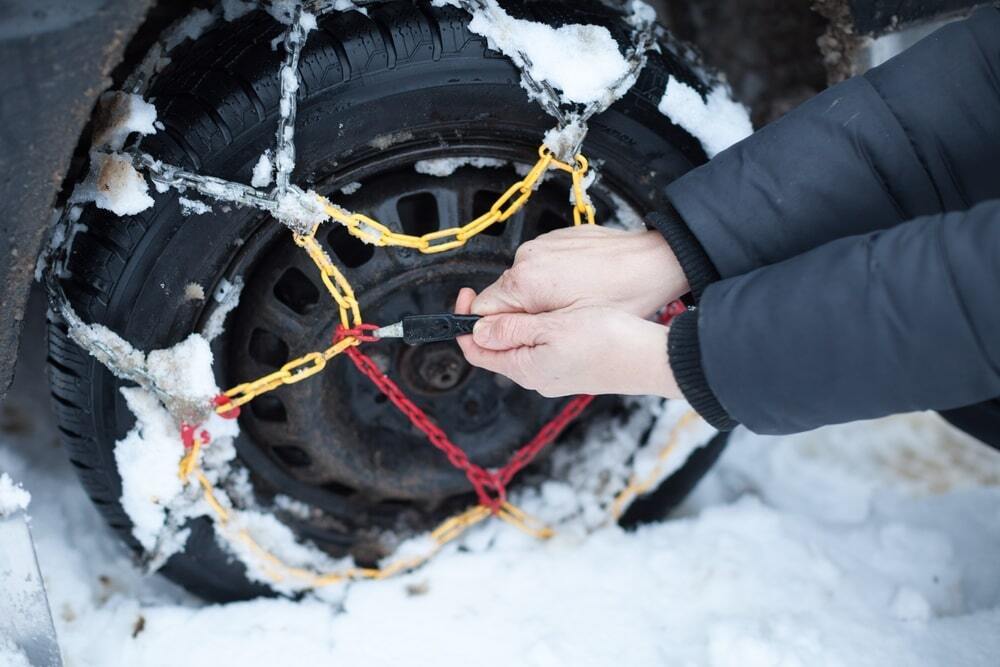 Before you travel in winter, check the chain requirements for your itinerary.
Before you travel in winter, check the chain requirements for your itinerary.
Before leaving for flight , it is important to check the condition of chains and store them in special cases or strong plastic bags. Worn out chains break in transit and can shatter headlights and fender liner, damage the fuel tank and cargo, get stuck between the wheels and cause an accident.
The chains must fit the wheel size of your truck. The specifics of its installation, the type of fastening and the degree of tension depend on the type of chain.
Do not accelerate and brake sharply when driving with chains on wheels, exceed the recommended speed: 50 km/h for metal chains and 80 km/h for soft chains (rubber, plastic). As speed increases, centrifugal force can cause the chains to loosen, causing the chain to vibrate and contact the fender liner.
Immediately after the pavement has been replaced with clean asphalt, the chains must be removed - otherwise they will wear out quickly. After removal, the chain must be cleaned and dried.
After removal, the chain must be cleaned and dried.
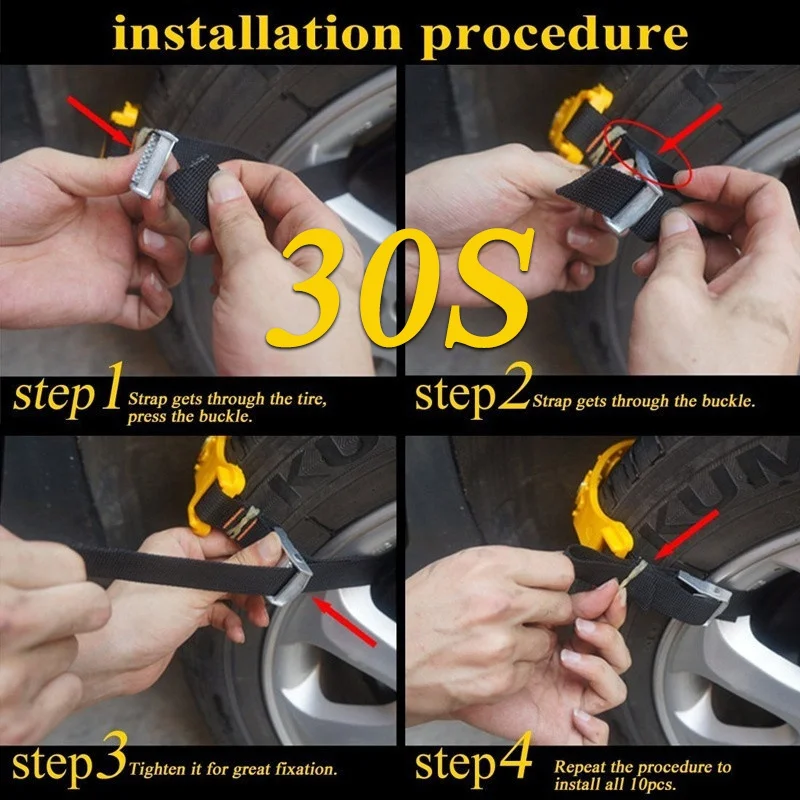
Quality used spare parts for Scania trucks can be found in our catalog
SEARCH FOR USED PARTS
A paradoxical thing: many drivers are so afraid of the procedure for installing chains on wheels that they are ready to abandon the chains in favor of some simplified devices such as bracelets, nets and the like. Although in fact it is the chains that are the easiest to install. However, this is true only if you know the basic techniques for putting a car in a chain.
Although in fact it is the chains that are the easiest to install. However, this is true only if you know the basic techniques for putting a car in a chain.
Snow chains on wheels significantly increase the vehicle's cross-country ability, but do not turn it into a tractor.
Before installing this powerful piece of equipment on a machine, consider whether the chained wheel looks like a photo or another machine. Understand the appearance and placement of each element of the chain: the working part, the side branches and the lock. Regardless of the brand, it is customary to highlight each element in its own color - to simplify putting the chain on the wheel.
See also: What not to do when driving on fresh snow
If you know the chain design and terminology, you can immediately go to the second part of the article, where we talk about mounting them on the car.
The working part is located on the tread, its elements cross the tread of the tire across or almost across, but usually there are several longitudinal links.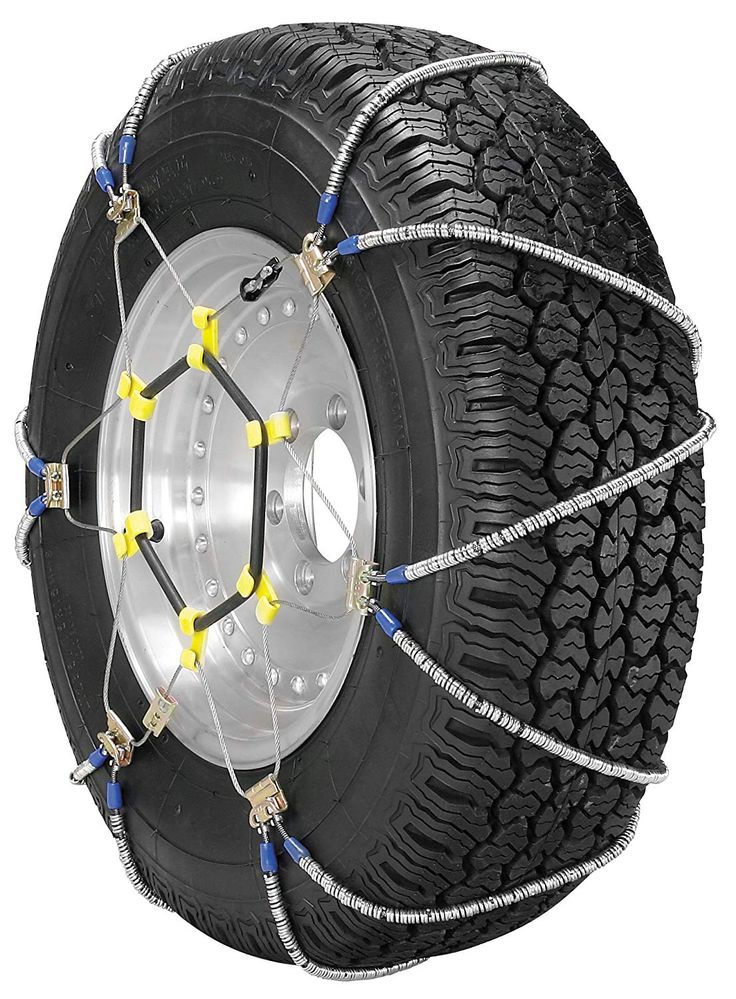 The working part of the chain has a neutral color, as a rule, this is the tone of the galvanized metal coating.
The working part of the chain has a neutral color, as a rule, this is the tone of the galvanized metal coating.
Properly dressed chains look like this. Side branches (red and blue) keep the working part on the tread
The side branches are ring-shaped and respectively hug the tire on both sides - they keep the working part of the chain on the tread. The outer side branch, like the working part, is made of the chain itself, the inner one, which is not visible on the car, is made of a rigid cable in a plastic sheath. The inner, cable branch is detachable, but has a fixed diameter. The outer branch is chain, consists of two parts and closes through a carabiner and a lock, thanks to which it easily changes the length (that is, the diameter). In addition, there is a hook with a rubber shock absorber on the outer ring. Lateral branches are usually colored: blue, red or yellow.
Lock is designed for tensioning the outer side branch (reducing its diameter) and fixing the diameter reached. Actually, it is located on the very side ring. Locks come in various designs, including those with automatic tension. They are often made in a bright color, usually red.
Actually, it is located on the very side ring. Locks come in various designs, including those with automatic tension. They are often made in a bright color, usually red.
See also: In the Carpathians with skis: we go to a resort with cars
There is nothing complicated in this operation, the only unpleasant thing about it is the need to squat near the wheels and the need to hold cold metal with your hands. Therefore, it is desirable to have gloves for such a case, preferably leather.
The algorithm for installing chains on wheels is generally simple. We advise you to use gloves and some kind of padding under your knees
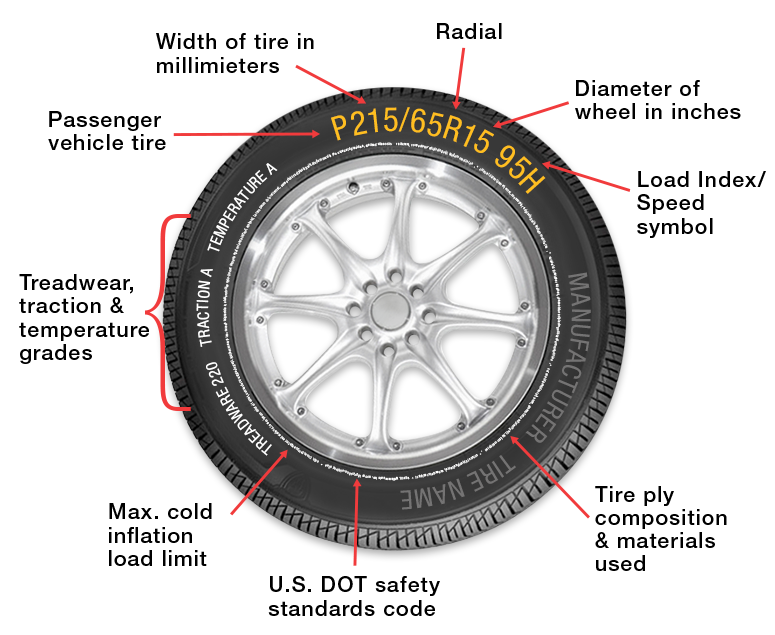
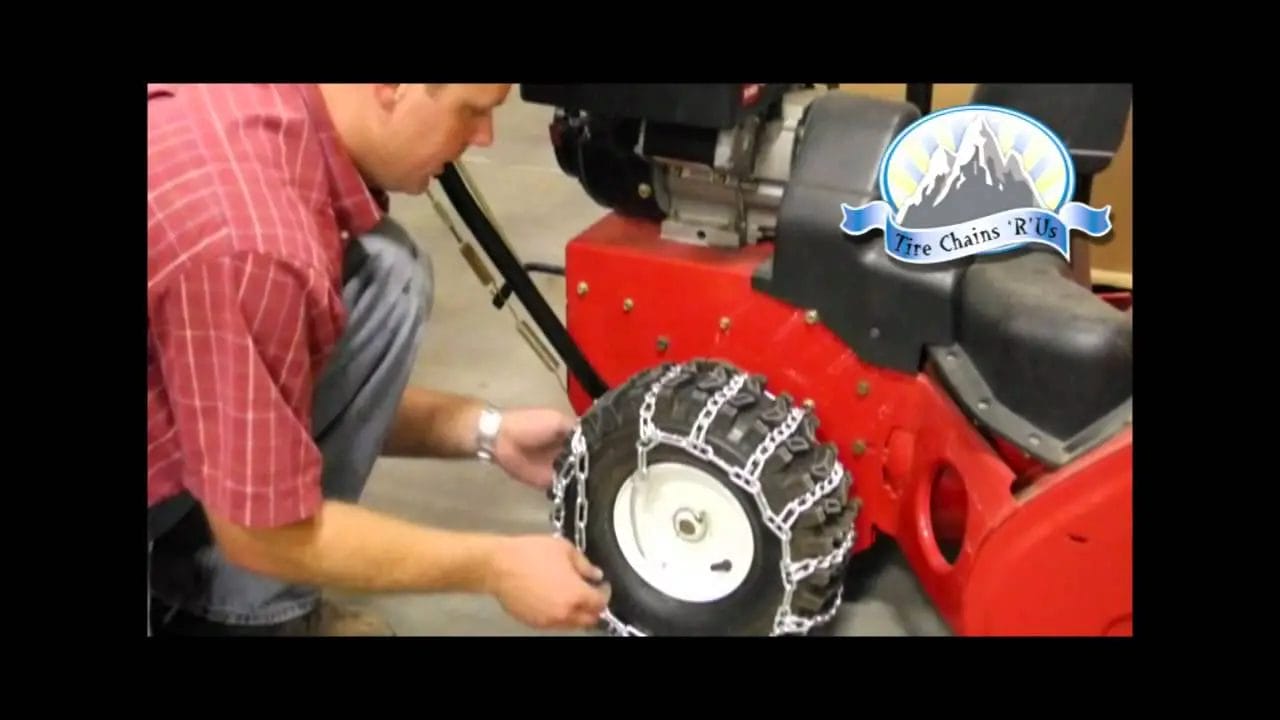
After putting on the chains, drive up to ten meters and tighten the side branch in the lock again (on the photo in red)
If your kit has a self-tightening lock, the last two operations are not necessary and you can go straight away. But it’s better to stop after a few minutes of driving, get out of the car and make sure that the chains fit the tires well. Keep in mind that in many cases the chain can scratch the wheel rim, which is not very pleasant for the owner, especially if the rims are alloy. But with a strong desire, you can almost always pick up a chain of such a size that it will not be located outside the bar.
Most chain manufacturers allow a maximum speed of 35 - 50 km/h.
Also remember that it is very important not to drive too fast with the chains on the wheels, as this will damage the tires, rims, and even the fenders of the car.